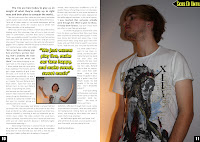Through the whole journey of creating this media product, I've learnt so much about the research, planning and producing of the magazine. I've found that these three factors are essential to creating a professional looking magazine. I learnt that applying the knowledge you gain from your market research to the final product, really helps to make sure you're attracting the right audience in the right way, and instantly giving yourself a reputation to this market.
There are still things that I think I would improve on in the future, like playing around with the layout of the first double page spread of the features page, as the layout and the way magazines are put together may not be best suited.
But, overall I am very pleased with my magazine, as I think it looks quite professional in the final outcome, with a long time perfecting paying off. I really enjoyed the making of the whole coursework and hopefully this can be seen from the finalisation of the project.












































